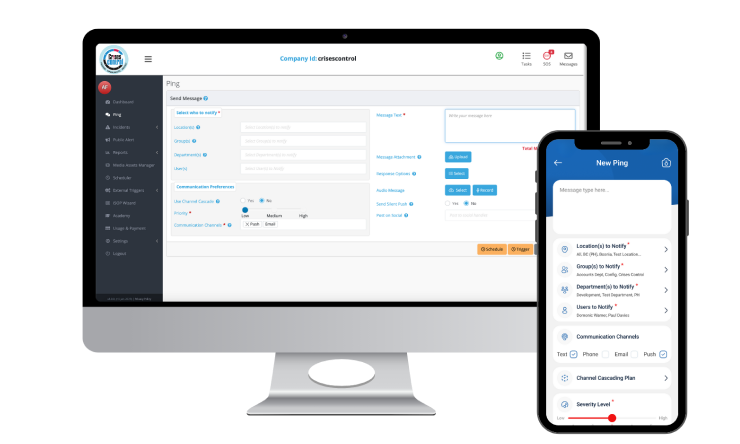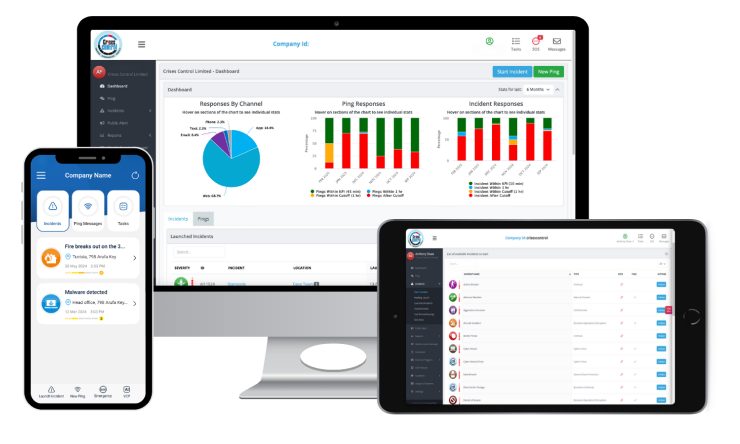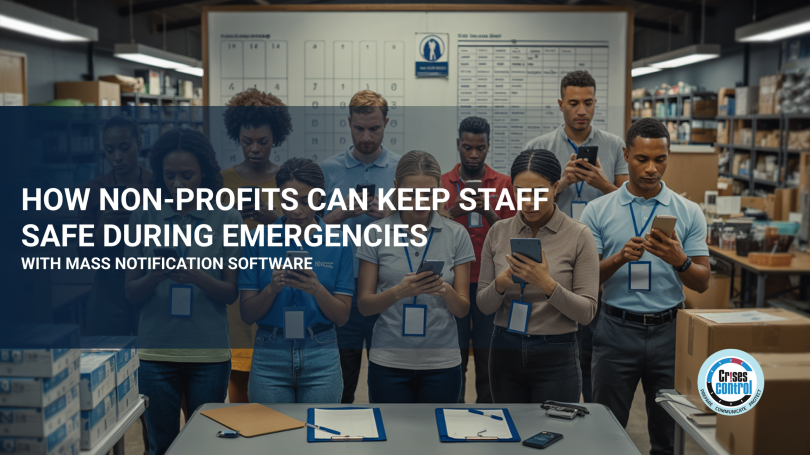Written by Anneri Fourie | Crises Control Executive
Non-profit organisations often operate in unpredictable and challenging environments. A crisis can unfold without warning: a flood closes down a community centre, an airstrike hits near a field office, a fire breaks out at a clinic, or a school goes into lockdown. In these moments, staff need to be informed quickly and accurately. Traditional communication methods like email or phone trees are often too slow or unreliable to manage such situations effectively.
Mass Notification Software can give non-profits a practical way to protect their teams during emergencies. By reaching the right people at the right time, it helps organisations act faster, keep staff safe and reduce disruption to their work. It also supports compliance with duty of care responsibilities and provides clear evidence of actions taken during an incident.
Why is staff safety a core priority for non-profits?
Many non-profits work in high-risk regions or provide essential services to vulnerable communities. Emergencies can be wide-ranging: severe weather, security incidents, terrorist attacks, fires, power outages, medical emergencies or operational disruptions. In some cases, the situation can escalate in minutes.
Unlike larger corporations, non-profits often work with leaner teams and limited resources. A single delay in communication can increase risks to staff and the people they support. It can also damage trust, interrupt services and lead to regulatory problems.
Having a clear emergency communication system in place is more than just good practice. It can be the difference between a controlled response and chaos. An organised approach also shows staff and volunteers that their safety is a genuine priority.
How can a mass notification system help non-profits?
An effective emergency communication system gives non-profits a way to send information quickly and reliably. Mass Notification Software allows teams to reach large or targeted groups across multiple channels at the same time. This can include SMS, voice calls, push notifications and email.
For non-profits with staff working in different locations, including areas where internet or phone networks may be unstable, a single platform creates consistency. Everyone receives the same information at the same time, which reduces confusion and helps people make safer decisions.
With a reliable system in place, organisations can:
- Activate Business Continuity Plans quickly.
- Alert staff and volunteers during critical events.
- Provide clear instructions to protect people and assets.
- Confirm staff safety and whereabouts.
- Keep records to support reporting and compliance.
This structured approach gives teams confidence that there is a clear plan when incidents happen.
How can non-profits protect their staff during emergencies?
Emergencies create pressure, and that is when communication failures often occur. Non-profits can use Mass Notification Software to take some of that pressure away. Pre-planned scenarios, targeted messaging and real-time feedback allow faster decisions and more effective action.
1. Rapid activation of pre-planned scenarios
Instead of starting from scratch in the middle of an emergency, incident templates can be set up in advance. For example, if a regional office needs to be evacuated, a pre-written alert can be sent to all affected staff within seconds. This reduces delays and ensures the message is accurate and consistent.
2. Targeted messaging for different situations
Not every incident needs a mass alert. A transport disruption might only affect a small group of staff, while a security incident could require wider communication. With targeted alerts, non-profits can choose exactly who receives each message based on location, department or role. This keeps communication relevant and avoids unnecessary panic.
3. Two-way communication for staff safety checks
Sending alerts is not enough on its own. Organisations also need to know if people are safe. Acknowledgement tracking allows staff to confirm receipt of alerts. SOS features give them a quick way to request help. Real-time feedback helps identify anyone who has not responded so support can be sent where it is needed.
4. Real-time communication across multiple channels
Email alone is unreliable in a crisis. A multi-channel approach means that if one channel fails, others can still reach the recipient. For example, a voice call might reach someone who doesn’t have internet access, while a push notification might be faster than SMS in some regions.
5. Incident reporting and accountability
Documenting what happens during and after an incident is often required for compliance and donor reporting. It also allows organisations to learn and improve their emergency response over time. A digital incident log provides a clear record of who was alerted, how they responded and what actions were taken.
What are the benefits of an emergency communication system?
Using a structured emergency communication system does more than just improve response times. It helps non-profits operate more effectively during a crisis.
Key benefits include:
- Faster response: Alerts can be sent within seconds, helping staff act sooner.
- Improved safety: Real-time communication helps staff follow clear instructions.
- Better operational continuity: Services can keep running, even during disruption.
- Regulatory compliance: Incident tracking supports audits and donor reporting.
- Staff confidence: Teams know there is a clear plan to protect them.
These benefits make a measurable difference to how quickly and effectively an organisation can respond.
Why Mass Notification Software works well for non-profits
Non-profits need tools that are reliable, easy to use and cost-effective. Mass Notification Software suits this need because it combines speed, reach and accountability.
- Speed and accuracy: Alerts can be launched in seconds.
- Scenario planning: Pre-configured messages ensure communication remains professional and clear under pressure.
- Global reach: Ideal for teams in multiple regions, including remote or high-risk areas.
- System integration: Alerts can be triggered through a web platform or mobile app.
- Clear reporting: Built-in audit trails support legal, regulatory and donor requirements.
This kind of system can become an essential part of a non-profit’s Business Continuity and emergency preparedness strategy.
Real-world scenarios where mass notification makes a difference
The impact of this technology becomes clearer when applied to real situations. These are examples drawn from actual use cases across the sector:
- A non-profit operating in a conflict zone uses the system to alert staff during airstrikes and confirm their safety.
- A health organisation triggers pre-set alerts to close clinics during a fire and reroute patients to safe locations.
- A school run by a charity uses targeted messaging during a lockdown, so only relevant teams receive alerts.
- A large NGO running field operations uses real-time alerts to manage evacuations during severe weather.
- An administrative office uses two-way communication to account for staff during a security incident.
Each scenario shows how fast, reliable communication can reduce risk and keep people safe.
What to look for in the best emergency alerting systems for non-profits
When selecting a platform, non-profits should look for more than just basic messaging features. The most effective systems offer:
- Multi-channel communication to reach everyone quickly.
- Location-based targeting for relevant messaging.
- Two-way communication with acknowledgements.
- Incident templates and automated scenarios.
- Detailed reporting and audit trails.
- A mobile app for field staff.
- Scalable architecture for different organisation sizes.
These features give non-profits the flexibility to respond to both local and large-scale emergencies.
How Crises Control can help
Crises Control provides a platform that helps non-profits communicate clearly and act quickly during emergencies. Its Mass Notification Software is built to support both small community organisations and large international NGOs.
Ways Crises Control supports non-profits include:
- Immediate incident activation using tailored scenarios.
- Alerts sent through multiple channels to reach staff anywhere.
- Real-time monitoring with SOS features and safety checks.
- A platform that is simple to use and easy to scale.
- Detailed reporting to support compliance and donor requirements.
This combination of speed, clarity and accountability strengthens duty of care and reduces operational risk. It also supports transparent communication, which helps build trust with staff, volunteers and stakeholders.
Interested in our Ping Mass Notification Software?
Efficiently alert everyone in seconds at scale with our Mass Notification Software.

Practical steps to strengthen emergency preparedness
Technology is only one part of a strong emergency response plan. Non-profits should combine tools like Mass Notification Software with clear procedures and regular training. Practical steps include:
- Create and share incident response plans with all teams.
- Build alert templates for common situations to save time.
- Segment staff groups by location or role for targeted alerts.
- Run regular tests to identify gaps and keep everyone familiar with the process.
- Train staff so they know how to respond to alerts.
- Review and adjust plans after each drill or incident.
A well-rehearsed plan supported by the right technology can make response efforts more organised and more effective.
Why taking a proactive approach matters
Many organisations only start planning after something goes wrong. By then, the damage has often already been done. A proactive approach to emergency communication gives non-profits time to prepare, train and build trust with their teams.
Mass Notification Software is not just a technical solution. It is a way to build resilience, meet legal responsibilities and protect the people who make the organisation’s work possible.
Take the first step towards safer operations
Crises Control offers non-profits a reliable way to communicate during emergencies. It helps organisations protect their people, maintain services and stay compliant, even in the most challenging situations.
If you want to strengthen your emergency response, contact us today to arrange a free demo. We will show you how the platform can support your organisation, helping you keep staff safe and your operations running with confidence.
Request a FREE Demo

